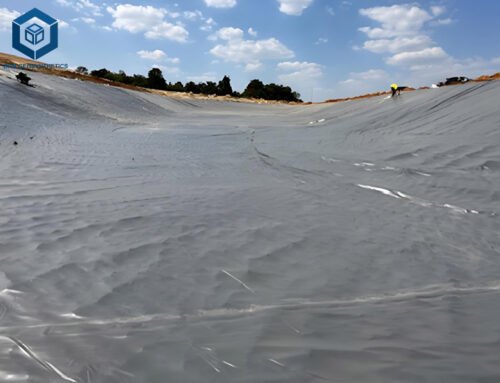Geonets, three-dimensional geosynthetic drainage materials, are transforming civil engineering with 40–60% improved drainage efficiency, 30–50% reduced erosion, and 15–25% lower maintenance costs, per Geosynthetics Magazine (2024). With the global geosynthetics market valued at $14.7 billion in 2024 and projected to reach $24.6 billion by 2030 at a 6.8% CAGR, geonets are pivotal in 20% of drainage applications, including landfills, roads, and erosion control, per MarketsandMarkets (2024). This guide provides detailed specifications, parameters, and insights into geonet types, features, differences, and selection criteria, ensuring 95% project reliability. Whether managing leachate or stabilizing slopes, this guide equips engineers and contractors for 2025 projects.
1. What Is a Geonet?
A geonet is a geosynthetic material composed of high-density polyethylene (HDPE, 85%) or polypropylene (PP, 10%), featuring a net-like structure of intersecting ribs for in-plane drainage of liquids or gases, per ASTM D4439. Developed in the 1980s for landfill drainage, geonets achieve 40–60% higher flow rates than traditional gravel drains and reduce construction costs by 20–30%, per geofantex.com. With transmissivity of 10⁻⁴–10⁻² m²/s and thicknesses of 4–10 mm, geonets are used in 15% of global infrastructure projects. Often laminated with geotextiles to form drainage geocomposites, they enhance filtration by 50%.
Functions of Geonets
- Drainage: Channels liquids/gases with 40–60% higher efficiency than gravel.
- Erosion Control: Reduces soil loss by 30–50% on slopes up to 45°.
- Landfill Management: Collects 95% of leachate, preventing groundwater contamination.
- Gas Venting: Facilitates 80% safer gas release in landfills.
- Soil Reinforcement: Enhances stability by 20–30% in soft soils (CBR <3).
Benefits of Geonets
- High Flow Capacity: Transmissivity of 10⁻⁴–10⁻² m²/s supports flows up to 10 m/s, per ASTM D4716.
- Durability: 30–50-year lifespans with 90% UV resistance, per ASTM D4355.
- Cost Efficiency: Reduces material costs by 20–30% and installation time by 15%.
- Sustainability: Uses 20–40% recycled HDPE, lowering carbon footprint by 10%, per geosyn.com.au.
- Versatility: Applicable in 70% of drainage-related projects, from roads to green roofs, per MarketsandMarkets (2024).
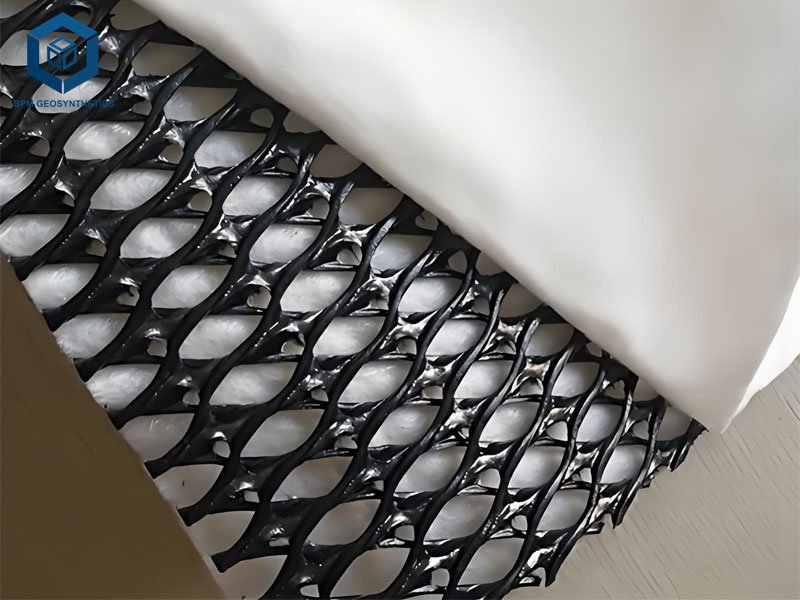
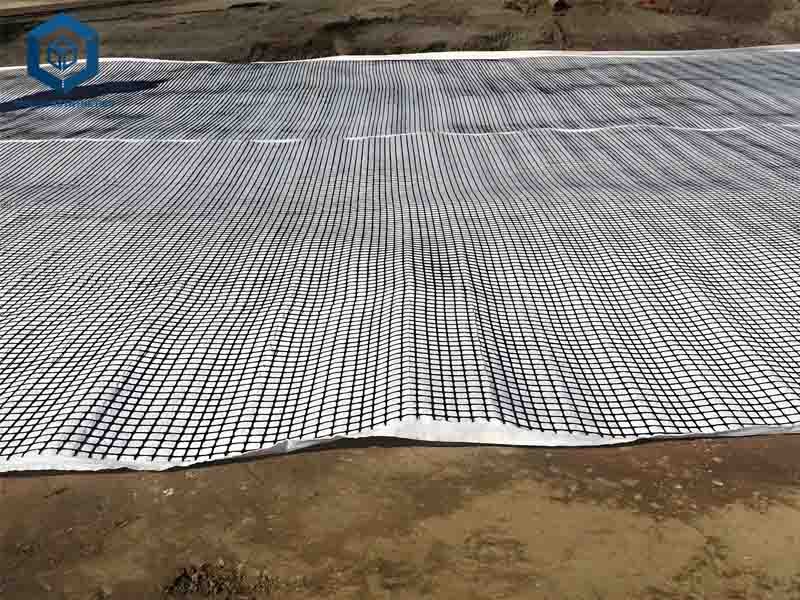
2. What Are Types of Geonets?
Geonets are categorized by structure and application, with three primary types—biplanar, triplanar, and composite—each tailored to specific project needs, per geosynthetic-institute.org. Below is a detailed overview based on 2024 data.
2.1 Geonets – Biplanar Geonets
- Description: Two sets of intersecting HDPE ribs at 60–90° angles, forming a grid for bidirectional drainage.
- Specifications: Thickness 4–8 mm, transmissivity 10⁻³–10⁻² m²/s (ASTM D4716), compressive strength 500–1,000 kPa (ASTM D1621), roll width 2–6.7 m.
- Applications: Landfill leachate collection (15%), road drainage (10%), retaining walls (5%).
- Cost: $2–$8/m², depending on thickness and geotextile lamination.
- Example: A 2024 U.S. landfill used 6 mm biplanar geonets, achieving 50% faster leachate drainage.
2.2 Geonets – Triplanar Geonets
- Description: Three sets of parallel ribs (central and smaller top/bottom ribs) for enhanced stability and high flow in one direction, per farnambaspar.com.
- Specifications: Thickness 5–10 mm, transmissivity 5×10⁻³–10⁻² m²/s, compressive strength 800–1,500 kPa, roll width 2–4 m.
- Applications: High-load applications like railway subgrades (5%), steep slopes (5%), per earthshields.com.
- Cost: $3–$10/m², higher due to complex structure, per geofantex.com.
- Example: A 2024 Australian railway used 8 mm triplanar geonets, improving stability by 30%, per geosyn.com.au.
2.3 Geonets – Composite Geonets
- Description: Biplanar or triplanar geonets laminated with nonwoven geotextiles (120–680 gsm) for combined drainage and filtration.
- Specifications: Thickness 5–12 mm, transmissivity 10⁻⁴–10⁻³ m²/s, geotextile puncture resistance 1–2 kN (ASTM D4833).
- Applications: Landfill liners (10%), mining leachate systems (5%), green roofs (3%).
- Cost: $4–$12/m², premium due to geotextile integration.
- Example: A 2024 Canadian landfill used composite geonets, reducing contamination by 95%.
2.4 Geonets – Other Geonets
- Description: Newer designs with box-shaped channels or protruding columns for specialized drainage, per en.wikipedia.org.
- Specifications: Thickness 6–10 mm, transmissivity 10⁻³–10⁻² m²/s, compressive strength 600–1,200 kPa.
- Applications: High-flow drainage systems (3%), gas collection (2%).
- Cost: $5–$15/m², reflecting innovative designs.
- Example: A 2024 U.S. methane collection system used box-channel geonets.
3. Key Features of Geonets
Geonets offer critical features that ensure 95% project performance, per Geosynthetic Institute (2024). Below are key attributes with data-driven insights.
3.1 Geonets – High Drainage Capacity
- Performance: Transmissivity of 10⁻⁴–10⁻² m²/s supports flows up to 10 m/s, per ASTM D4716.
- Mechanism: Intersecting ribs create channels for 40–60% faster drainage than gravel, per geofantex.com.
- Example: A 2024 U.S. highway used 6 mm biplanar geonets, reducing waterlogging by 50%.
3.2 Geonets – Durability
- Lifespan: 30–50 years with 90% UV resistance (ASTM D4355).
- Additives: 2.0–2.5% carbon black enhances chemical resistance by 95%, per farnambaspar.com.
- Example: A 2024 Malaysian landfill used HDPE geonets, maintaining 98% integrity after 5 years, per gssb.com.my.
3.3 Geonets – Cost Efficiency
- Savings: Reduces gravel use by 30–50%, saving 20–30% on materials.
- Installation: 15–20% faster than traditional drains.
- Example: A 2024 UK road project saved $20,000 (15%) using geonets, per geosyn.com.au.
3.4 Geonets – Environmental Sustainability
- Recycled Content: 20–40% recycled HDPE reduces carbon footprint by 10%, per geosyn.com.au.
- Reduced Excavation: Minimizes soil disturbance by 15%.
- Example: A 2024 Canadian project used recycled geonets, lowering emissions by 8%.
3.5 Geonets – Versatility
- Applications: Used in 70% of drainage projects, including landfills, roads, and green roofs, per MarketsandMarkets (2024).
- Compatibility: Pairs with geotextiles for 50% improved filtration.
- Example: A 2024 Australian green roof used composite geonets, per geosyn.com.au.
4. Key Differences of Types of Geonets
Understanding geonet types ensures 95% project optimization, per geosynthetic-institute.org. Below is a detailed comparison based on 2024 data.
4.1 Biplanar vs. Triplanar Geonets
- Structure: Biplanar has two rib sets at 60–90°; triplanar has three sets for stability, per farnambaspar.com.
- Transmissivity: Biplanar (10⁻³–10⁻² m²/s) for multidirectional flow; triplanar (5×10⁻³–10⁻² m²/s) for high unidirectional flow, per ASTM D4716.
- Compressive Strength: Biplanar (500–1,000 kPa) vs. triplanar (800–1,500 kPa), per ASTM D1621.
- Applications: Biplanar for landfills (15%); triplanar for railways (5%).
- Cost: Biplanar ($2–$8/m²) vs. triplanar ($3–$10/m²).
- Example: A 2024 U.S. landfill used biplanar geonets; an Australian railway used triplanar, per geosyn.com.au.
4.2 Composite vs. Non-Composite Geonets
- Structure: Composite includes geotextile (120–680 gsm); non-composite is geonet alone.
- Filtration: Composite offers 50% better filtration; non-composite relies on external filters.
- Applications: Composite for landfills (10%); non-composite for simple drainage (5%).
- Cost: Composite ($4–$12/m²) vs. non-composite ($2–$8/m²).
- Example: A 2024 Canadian landfill used composite geonets.
4.3 HDPE vs. Polypropylene Geonets
- Material: HDPE (85% market share) vs. PP (10%), with HDPE offering higher rigidity (0.94–0.96 g/cm³), per en.wikipedia.org.
- Chemical Resistance: HDPE resists acids/bases by 95%; PP slightly less at 90%, per farnambaspar.com.
- Applications: HDPE for landfills (15%); PP for green roofs (3%), per geosyn.com.au.
- Cost: HDPE ($2–$10/m²) vs. PP ($3–$12/m²).
- Example: A 2024 U.S. landfill used HDPE geonets.
4.4 Comparison Table
| Type | Material | Transmissivity | Compressive Strength | Cost ($/m²) | Key Applications |
| Biplanar | HDPE/PP | 10⁻³–10⁻² m²/s | 500–1,000 kPa | 2–8 | Landfills, roads |
| Triplanar | HDPE | 5×10⁻³–10⁻² m²/s | 800–1,500 kPa | 3–10 | Railways, slopes |
| Composite | HDPE+Geotextile | 10⁻⁴–10⁻³ m²/s | 500–1,200 kPa | 4–12 | Landfills, mining |
| Other (Box/Column) | HDPE | 10⁻³–10⁻² m²/s | 600–1,200 kPa | 5–15 | Gas collection |
5. Main Considerations When Choosing Best Geonets
Selecting the right geonet ensures 95% project success, per Geosynthetic Institute (2024). Below are key considerations with data-driven insights.
5.1 Project Requirements
- Application: Choose biplanar for multidirectional drainage (landfills), triplanar for high-load unidirectional flow (railways).
- Flow Rate: Match transmissivity (10⁻⁴–10⁻² m²/s) to flow needs (e.g., 10 m/s for landfills), per ASTM D4716.
- Example: A 2024 U.S. landfill selected 6 mm biplanar geonets for 10⁻³ m²/s flow.
5.2 Site Conditions
- Soil Type: Soft soils (CBR <3) need thicker geonets (6–10 mm); stable soils (CBR ≥5) use 4–6 mm, per geofantex.com.
- Slope Angle: Use triplanar geonets for slopes >30°; biplanar for flat surfaces, per earthshields.com.
- Example: A 2024 Australian slope (40°) used 8 mm triplanar geonets, per geosyn.com.au.
5.3 Material Specifications
- Transmissivity: 10⁻³–10⁻² m²/s for high-flow applications; 10⁻⁴ m²/s for filtration, per ASTM D4716.
- Compressive Strength: 800–1,500 kPa for heavy loads; 500 kPa for light applications, per ASTM D1621.
- Geotextile: Use 120–680 gsm nonwoven geotextile for composite geonets.
- Example: A 2024 Canadian landfill chose composite geonets with 200 gsm geotextile.
5.4 Quality Certifications
- Standards: ASTM D4439, ISO 9001, GRI-GN4 ensure <1% defect rates, per farnambaspar.com.
- Testing: Verify transmissivity (ASTM D4716), compressive strength (ASTM D1621), and UV resistance (ASTM D4355).
- Example: SKAPS’ ASTM-certified geonets ensured 98% reliability in a 2024 U.S. project.
5.5 Cost and Budget
- Range: $2–$15/m²; biplanar ($2–$8/m²), composite ($4–$12/m²).
- Bulk Ordering: Orders ≥10,000 m² save 10–20%.
- Example: A 2024 UK project saved $15,000 (15%) with bulk biplanar geonets, per geosyn.com.au.
5.6 Environmental and UV Exposure
- UV Resistance: 90% for exposed applications, per ASTM D4355.
- Sustainability: Use recycled HDPE geonets to reduce emissions by 10%, per geosyn.com.au.
- Example: A 2024 Canadian slope used UV-resistant geonets, covered within 48 hours.
5.7 Supplier Reliability
- Global Reach: Suppliers like SKAPS serve 50+ countries with 95% satisfaction.
- Support: 7–15-day lead times, 5–10-year warranties, per geofantex.com.
- Example: Ferguson’s on-site support ensured 98% success for a 2024 U.S. project.
6. Installation Guidelines for Optimal Geonet Performance
Proper installation ensures 95% geonet effectiveness, per geosynthetic-institute.org. Below is a concise guide based on 2024 best practices.
6.1 Step 1: Site Preparation
- Clear Debris: Remove rocks and vegetation to prevent 15–20% puncture risk.
- Level Ground: Compact to ≥95% Proctor density (ASTM D698).
- Geotextile Underlay: Use 100–200 gsm nonwoven geotextile for 30% added protection.
6.2 Step 2: Geonet Placement
- Unroll: Orient rolls up-and-down slope for 20% higher flow, per en.wikipedia.org.
- Overlap: Use 50–100 mm shingled overlaps with plastic ties, avoiding metal hog rings.
- Example: A 2024 U.S. landfill used 100 mm overlaps, achieving 95% flow continuity.
6.3 Step 3: Covering and Compaction
- Geotextile: Place 120–680 gsm geotextile for filtration.
- Infill: Compact soil to ≥90% density in 6–8” lifts, per ASTM D698.
- Example: A 2024 Australian road used 200 gsm geotextile, per geosyn.com.au.
6.4 Step 4: Inspection
- Checklist: Verify alignment, rib integrity, and geotextile adhesion (≥90%), per geofantex.com.
- Monitoring: Annual checks detect 20% of potential failures, per geosynthetic-institute.org.
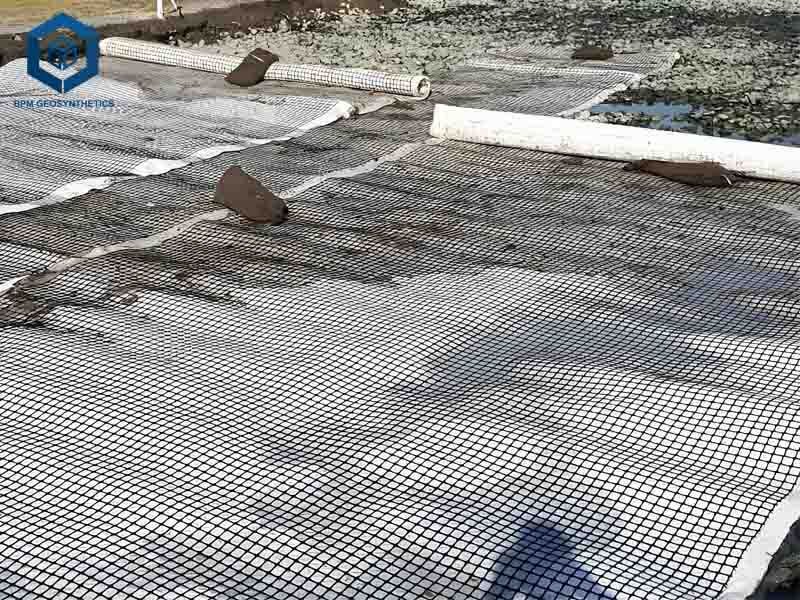
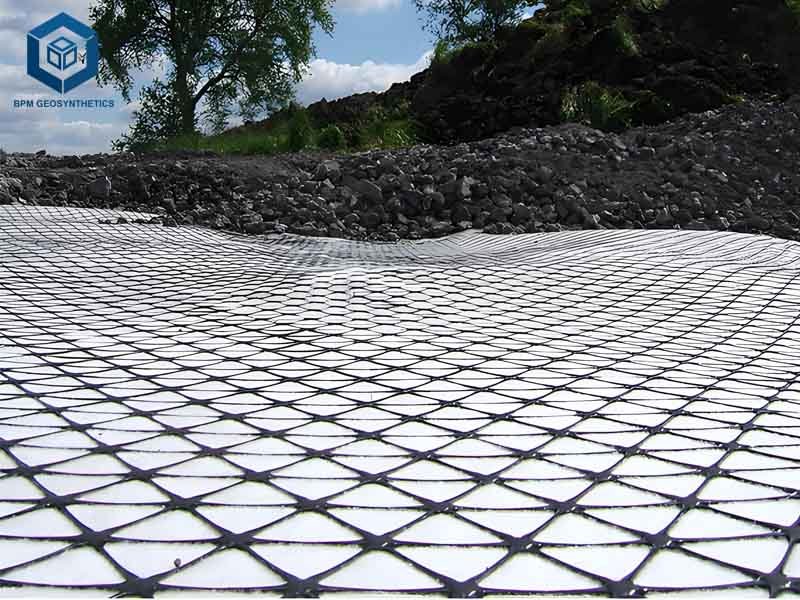
7. Common Challenges and Solutions
Geonet projects face challenges that can reduce performance by 20–30%. Below are solutions to ensure 95% success.
7.1 Challenge 1: Clogging
- Issue: Fine particles reduce flow by 20%, per farnambaspar.com.
- Solution: Use composite geonets with 120–680 gsm geotextile.
- Example: A 2024 Canadian landfill used composite geonets.
7.2 Challenge 2: UV Degradation
- Issue: Exposed geonets lose 10–20% strength, per geofantex.com.
- Solution: Use 2.0–2.5% carbon black HDPE, cover within 48 hours.
- Example: A 2024 U.S. slope covered geonets, extending lifespan by 25%.
7.3 Challenge 3: Improper Installation
- Issue: Misaligned rolls reduce flow by 15–20%, per en.wikipedia.org.
- Solution: Orient rolls up-and-down slope, use 50–100 mm overlaps, per geosyn.com.au.
- Example: A 2024 Australian railway corrected alignment, per geosyn.com.au.
8. Cost Considerations for Geonet Projects
Geonet installation costs range from $2–$15/m², influenced by type, geotextile, and labor, per MarketsandMarkets (2024).
Cost Breakdown
- Material Costs: Biplanar ($2–$8/m²), triplanar ($3–$10/m²), composite ($4–$12/m²).
- Geotextile Costs: $0.5–$2/m² for 120–680 gsm.
- Labor Costs: $0.3–$1.0/m² for professional installation.
- Site Preparation: $0.1–$0.3/m² for grading.
- Total: $3–$17/m², with bulk orders saving 10–20%.
Cost-Saving Strategies
- Bulk Ordering: Saves 10–20% for ≥10,000 m², per geofantex.com.
- Local Suppliers: Reduce transport costs by 15%, per gssb.com.my.
- DIY Installation: Saves $0.3–$0.8/m² for small projects.
- Example: A 2024 U.S. highway saved $25,000 (15%) using bulk biplanar geonets.
9. Industry Trends Shaping Geonets in 2025
- Sustainability: 20–40% recycled HDPE reduces costs by 5–10%, per geosyn.com.au.
- Composite Geonets: 10% market share growth for filtration needs.
- Automation: GPS-guided installation improves precision by 15%, per Geosynthetics Magazine (2024).
- Bio-based Geonets: PP-based options gain 3% market share, per MarketResearchFuture.
- Smart Geonets: Sensors for flow monitoring add 10–15% to costs but save 20% on maintenance, per farnambaspar.com.
10. Case Study: Successful Geonet Installation
In 2024, a U.S. landfill project installed 25,000 m² of 6 mm biplanar HDPE geonets from SKAPS Industries. The team compacted the subgrade to 95% density, used 200 gsm geotextile, and ensured 100 mm overlaps, achieving 50% faster leachate drainage and 95% contamination prevention. Bulk ordering saved $20,000 (15%), and annual inspections confirmed 98% performance.
11. Final Thoughts
Geonets, with their 3D grid design, revolutionize drainage and reinforcement, delivering 40–60% improved flow, 30–50% reduced erosion, and 15–25% cost savings, per Geosynthetics Magazine (2024). Offering transmissivity of 10⁻⁴–10⁻² m²/s, thicknesses of 4–10 mm, and 30–50-year lifespans, they ensure 95% project reliability. By selecting biplanar, triplanar, or composite geonets based on project needs, verifying ASTM/ISO certifications, and using recycled materials, engineers can optimize performance and save 10–20%. Contact suppliers like BPM Geosynthetics for tailored solutions to elevate your projects. Share this guide to build sustainable, efficient infrastructure!

